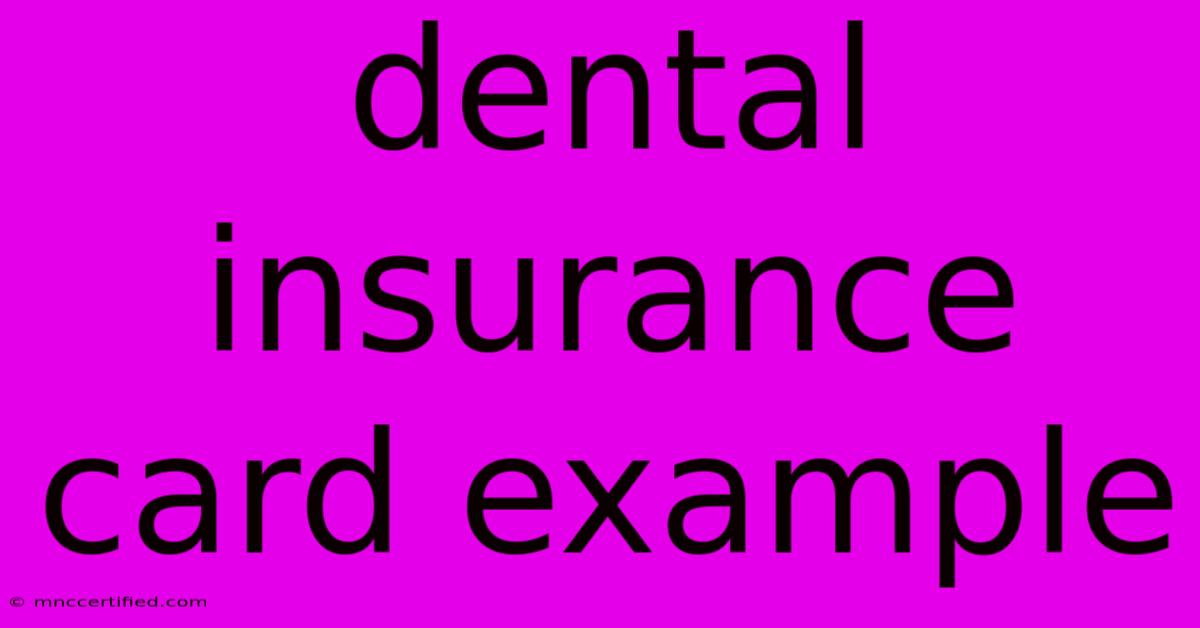Dental Insurance Card Example

Table of Contents
Understanding Your Dental Insurance Card: A Comprehensive Guide
Finding the right dental insurance can feel overwhelming, but understanding your dental insurance card is the first step to accessing affordable and quality dental care. This guide provides a comprehensive overview of what you'll find on a typical dental insurance card and how to use it effectively. We'll cover everything from identifying key information to understanding potential limitations.
What's on a Dental Insurance Card? Essential Information You Need to Know
Your dental insurance card acts as your key to accessing benefits. A typical card will display crucial information, including:
- Your Name and Date of Birth: This verifies your identity and ensures you're accessing the correct coverage.
- Your Member ID Number: This unique number links you to your specific insurance policy and is essential for claims processing. Never share this number unless absolutely necessary.
- Your Group Number: This identifies your employer or group plan associated with your coverage.
- Your Plan Name and Type: This clarifies the type of dental insurance you have (e.g., PPO, HMO, EPO). Understanding your plan type is critical to knowing how to use your benefits.
- Your Effective Dates: These indicate the start and end dates of your coverage period. Note these dates to avoid gaps in coverage.
- Your Primary Care Provider (PCP) Information (if applicable): HMO plans often require you to select a PCP, and this information will be listed here.
- The Insurance Company's Contact Information: This provides the necessary details to contact the insurer for inquiries regarding your coverage, claims, or general questions.
- Customer Service Number: This is the direct line to reach the insurance provider for any queries related to your coverage.
Decoding Dental Insurance Plan Types: PPO vs. HMO vs. EPO
Different dental insurance plans offer varying levels of flexibility and cost-effectiveness. Understanding your plan type is essential for maximizing your benefits.
- PPO (Preferred Provider Organization): PPO plans generally offer more flexibility. You can see any dentist, but you'll typically pay less if you choose an in-network dentist.
- HMO (Health Maintenance Organization): HMO plans usually require you to select a primary care dentist (PCP) within the network. Seeing out-of-network dentists will likely result in significantly higher out-of-pocket costs.
- EPO (Exclusive Provider Organization): EPO plans are similar to HMOs, requiring you to see in-network dentists. However, EPOs generally don't allow out-of-network visits unless it is an emergency.
Beyond the Basics: Understanding Your Dental Insurance Benefits
Your dental insurance card is just the beginning. To truly understand your coverage, review your plan's Summary of Benefits and Coverage (SBC). This document outlines:
- Annual Maximum: This is the total amount your insurance will pay towards your dental care within a year.
- Deductible: The amount you must pay out-of-pocket before your insurance begins to cover services.
- Copay: A fixed amount you pay for each visit.
- Coinsurance: The percentage of costs you share with your insurance company after meeting your deductible.
- Covered Services: Specific procedures or treatments your plan covers, like checkups, cleanings, fillings, and orthodontics.
Using Your Dental Insurance Card Effectively: Tips and Tricks
- Always present your card at every dental appointment. This ensures your information is recorded accurately and helps with claims processing.
- Verify your benefits before receiving treatment. Contact your insurance provider or use their online portal to confirm coverage for procedures. This prevents unexpected bills.
- Keep a copy of your card and your SBC in a safe place. This is useful for reference and for making claims if the card is lost or damaged.
- Understand your plan's limitations. Knowing what's covered and what isn't prevents unpleasant surprises regarding costs.
- Keep track of your dental expenses. This helps you monitor your out-of-pocket spending and ensure accurate claims submissions.
What to Do If Your Dental Insurance Card is Lost or Stolen
If your dental insurance card is lost or stolen, contact your insurance company immediately. They'll help you report the loss and issue a replacement card. Never share your member ID number with anyone you don't trust.
By understanding your dental insurance card and the details of your plan, you can navigate the dental care system with confidence and ensure you receive the best possible treatment within your budget. Remember to always review your Summary of Benefits and Coverage for the most accurate and up-to-date information.

Thank you for visiting our website wich cover about Dental Insurance Card Example. We hope the information provided has been useful to you. Feel free to contact us if you have any questions or need further assistance. See you next time and dont miss to bookmark.
Featured Posts
-
Top Walmart Black Friday Deals Now
Nov 29, 2024
-
2024 National Dog Show Results
Nov 29, 2024
-
Why Shaboozey Performs Bears Lions
Nov 29, 2024
-
My Walmart Black Friday Deal Preview
Nov 29, 2024
-
Live Stream Heidenheim Vs Chelsea Match
Nov 29, 2024